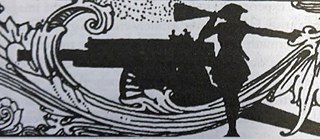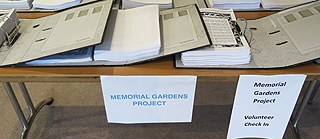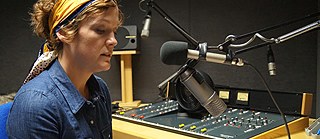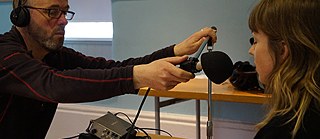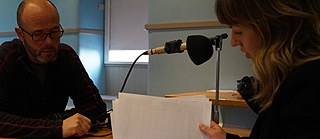Voices of Memory
The Art Project
The Artist about the Project
Voices of Memory 2014 - 2016
On my first visit to Dublin in 2014 one of the things that impressed me was the way the river Liffey changes beyond the city centre. The river suddenly becomes a large stream with natural borders, surrounded by a variety of plants. The Irish War Memorial Gardens, situated along the Liffey, seem characterised by this aspect of the river. The gardens are not a typical tourist destination. Most people visiting seem to be a mixture of locals, dogs and their walkers, cyclists and rowing teams. The sounds of the nearby busy road contrast and cut through the calm atmosphere in the rose gardens, the green meadows and among the stoic Victorian monuments. The beautiful park, although difficult to reach, seems like an island removed from the hectic city life that encourages a different experience of time and place.
While visiting the pavilions in the gardens which house photographs and memorabilia from World War I, I was particularly taken by a beautifully illustrated book on display. This book was one of 8 volumes of Ireland's Memorial Records, compiled by the Committee of the Irish National War Memorial under the direction of the Earl of Ypres and published in 1923 with the stunning illustrations by artist Harry Clarke. The books were intended to serve as a lasting memorial to the thousands of men who served in Irish regiments and died during the Great War.The volumes list the names of almost 50,000 individuals that came from all over Ireland, North and South and as well other countries. As well as their names, they record the birth place and the dates of death of the fallen soldiers. Looking at this book the number of names seemed endless and the loss of life quite incredible. While reading some of the pages I noticed a lot of repetition; many names sound similar or are even the exact same. For example, there are 44 listings of young men all named John Ryan! In my work as a sound artist and composer I have worked with the human voice on many different occasions. However, this list of names is very special because of the political and emotional impact it has. I believed these names should not only be read but also be heard, as a flow of voices in a never ending sequence, as a kind of composition with subtle reworking. And as a way to commemorate all these dead people.
In the following two years, just over 42,000 names were recorded by volunteers, thanks to Dublin City Council, Fergus Kelly, the sound artist and technician and two project co-ordinators. The volunteer readers were composed of different ages, sex, nationalities and occupations. Not surprisingly there is an enormous variety in the resulting recordings. What’s more they are quite emotional in places, especially during the repetitions of fallen soldiers with similar names.
These recordings became the basic material for Voices of Memory.
The sound installation Voices of Memory is located at the bank of the Liffey in the Irish National War Memorial Gardens. An old electrical pole holds four speakers, one of them, directed towards the garden, is a typical horn loudspeaker which transmits a voice composition based on the recordings. The structure of the installation respects the alphabetical sequence of the record books as well as the characteristics of the different recorded voices. Sometimes the sequence of names becomes a dense almost abstract acoustic sound, sometimes they can be heard clearly as single names. Between the flow of names there are intervals in which the sounds of the Liffey can be heard and then disappear. These recordings were made with hydrophones (underwater microphones) placed directly in the river. During my second visit to the gardens, while testing the hydrophones, not only did I hear the water and the rhythms of the rowing boats, but I also picked up the tiny and wonderfully surprising sounds of underwater insects and animals. These river sounds, which seem to follow their own natural rules, come and go during the endless flow of voices, offering the listener a pause for reflection and thought.
(Christina Kubisch)
The Recordings
Original Plan
In her proposal for this artwork Christina Kubisch suggested that a minimum of 10,000 of the names in Ireland's Memorial Records be recorded. Significantly, Kubisch recommended that the names be read by a mixture of young, middle-aged and older local citizens. This variety was important, not only for symbolic reasons, but also desired as it would enhance the texture of the final piece. As stated in her proposal: “Each voice of a person has a special timbre and way of reading and a large variety of ‘sound readings’ will create an acoustic variety which corresponds to [the] many individuals which are named.”
To this end, following a call out in November 2015 and April 2016 by Dublin City Council and the Goethe-Instiut Irland, 192 people got in contact with us looking to take part. In the end, we had 178 readers in total.
178 Volunteers, 4 locations, 9 days of recording, 42,116 names
Locations
The recordings took place in four different locations in Dublin: Dublin City Council Offices on Wood Quay, the Arts Office on Foley Street, the Goethe-Institut Irland and Collins Barracks. Recordings took place in two separate weeks. The first sessions were held from Tuesday 3 November to Saturday 7 November 2015. The second round of sessions took place from Tuesday 26 April until Saturday 30 April 2016. This amounted to nine full days of recording (or four and a half days each time).
Proceeding
On each day volunteers were asked to give 30 minutes of their time. Prior to recording they registered with our co-ordinators and were briefed about the procedure of recordings. Each volunteer was given a section of pages with soldiers’ names from Ireland’s Memorial Records. Over ten minutes volunteers were asked to read the first and surnames of each solider listed in their bundle with our sound technician Fergus Kelly. On average volunteers read 16 pages per session. With each page containing 16 names, approximately 256 names were recorded in each session.
Volunteer Readers
Volunteers came from across Dublin and Ireland to participate in the recording sessions and represented a cross section of society. Made up of both males and females, our volunteers ranged in age, nationality and occupation. We met secondary school students, retired men and women, education developers, German and Greek interns, Collins Barracks’ staff, and Trustees of the Irish National War Memorial Gardens. We were joined by family and friends, therapists, artists, curators, the former Major General of the Irish Army, and a General Brigadier of the Air Corps. A large portion of our volunteers were also Dublin City Council staff. Staff members that took part came from a wide range of departments, including but not limited to, City Architects, the Arts Office, HR, Housing, Drainage, Roads, Events, Parks and Landscape, Libraries, Roads and Traffic, Waste Management, Corporate Services, Press and Communications, Planning, Rates, Finance and Procurement, and Management Services. We had volunteers who were Clerical and Administration Staff, members of the Fire Brigade Services, a staff member of the Air Quality and Noise Control Unit as well as Health and Safety Officers. In short, an excellent mix.
The Experience
Reading the names was a different experience for each volunteer. A few volunteers were able to read the names of a relative having notified us beforehand while others took some time after their session to search our folders of sheets for their relative’s name. Understandably, for these men and women the experience was a special one. On reading pages of men who shared their surname, volunteers were duly moved by this simple, personal connection. Some volunteers expressed a desire to change their tone of voice for each name, in order to give each solider a sense of individuality and their due respect. Others expressed that “it was harder and more emotional than [they] thought it would be” before handing back a pile of recorded pages and continuing on with their day. And, of course, this was not an easy task. Yet, all rose to the challenge.
It was an interesting experience for us, the Dublin City Council, as well. Not only did we get to hear volunteers’ stories, we engaged intimately with the records. We grew familiar with Harry Clarke’s beautiful designs, we turned through pages and pages of Byrnes, Murphys, and Smiths, we found and recorded two women’s names.
The Result
Initially we planned for 10,000 names be read. Out of 49,647 names, a total of 42,116 names were read by the volunteers. Although the piece speaks for itself it is still valuable to take note of the final tally. This is a huge achievement, far out reaching the set target. After having been recorded the files were sent, untouched and unaltered, to Christina Kubisch for editing and layering. What you hear in Islandbridge is the final result. We would like to thank our sound technician (and sound artist) Fergus Kelly, staff at the Goethe-Institut Irland, Collins Barracks and Civic Offices that facilities recording sessions and, of course, all the readers involved for making this possible.
(Olivia Laumenech)
The Location
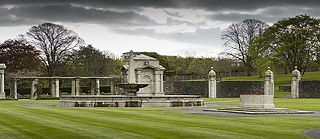
The decision to build such a permanent memorial site to commemorate all Irish soldiers who lost their lives in WW I was made on the 17 July 1919 at a meeting of representatives from all over Ireland. However, it was not until 1929 that the Irish Government finally suggested building the memorial park on the site known as Longmeadows on the south bank of the Liffey, which stretches from Islandbridge towards Chapelizod. The construction began in 1931 and the park was laid out between 1933 and 1939 by a workforce consisting of 50% ex-British Army servicemen and 50% ex-servicemen form the Irish National Army.
On the 1 July 2006 the first official ceremony to commemorate the Irish war dead was held in the Irish National War Memorial Gardens. Attended by the then President of Ireland Mary McAleese and the Taoiseach Bertie Ahern it took place on the occasion of the state commemoration on the 90th anniversary of the Battle of the Somme. In 2011 Queen Elizabeth II visited the Memorial Gardens and honoured the Irish soldiers who had died fighting for Britain between 1914 and 1918.
(Franziska Hülshoff)
The Books by Harry Clarke

Harry Clarke, already very well-known and highly-regarded for his work in book illustration and stained glass, was commissioned for the border decoration of the books. He created eight different designs (including a front and back page), which are repeated and reversed throughout the set (16 different arrangements in total). The silhouettes of military scenes mixed with drawings in black ink from Celtic mythology are unique of its time. Finally, in 1923 almost 50,000 names listed alphabetically were published in eight volumes on 3,200 pages. In addition, there is information about rank, regiment, age, how they died, and where they had been born. Around 30,986 of the soldiers listed were born in Ireland, 4,800 of them are Dubliners. 100 copies of each book were printed, in 1995 the books were digitized in CD-Rom form. In 2014 Ireland's Memorial Records were made searchable online.
(Franziska Hülshoff)
The Artist
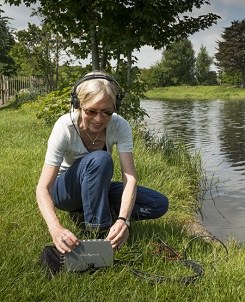
Starting with performances, concerts, and works with video she has increasingly specialized in sound art since 1980 by creating her first sound installations and sound sculptures. Soon she began applying techniques of magnetic induction to her artistic works and from 1986 she used ultraviolet light as well. 1990-91 she developed solar-controlled techniques for her sound sculptures. Alongside her artistic work Christina Kubisch was visiting professor at numerous universities, such as the Jan von Eyck Akademie Maastricht, the Art Academy Münster, the University of Arts in Berlin, and the Ecole Nationale Supérieure des Beaux Arts in Paris.
Her music has been released with various labels such as Cramps Records, Edition RZ, ampersand, semishigure, Die Schachtel, Olof Bright, AA Records, Important Records, Gruenrekorder and others. Christina Kubisch is a member of the Akademie der Künste Berlin since 1997.
Christina Kubisch has been awarded numerous national and international scholarships and prizes, such as the composition grant of the city of Berlin (1995 and 2000) and the Carl Djerassi Honorary Fellowship (California 2000). She was awarded the Honorary Award of the German Sound Art Award (Deutscher Klangkunstpreis) in 2008 and the SR Media Art Award (Medienkunstpreis) in 2009. In addition, she was the city sound artist Bonn in 2013.
Since 1974 her solo exhibitions have been shown in Europe, USA, Australia, Japan and South America, and she participated in various international festivals and group exhibitions, for instance in bonnhoeren (Beethovenstiftung Bonn 2013), festival NOW (Essen 2014), blurred edges festival (Hamburg 2015), and Free Sound (Osaka 2016).
Christina Kubisch’s latest projects are, among others, the sound installation Rheinklänge (fluid landscapes) in Bonn (2013), the radio piece Remote Future Control Access for Skálar FM and the solo exhibition Hidden From View in Berlin (both 2015).
In Ireland she has previously presented her work in cooperation with the Goethe-Institut Irland at the open symposium Beyond Noise and Silence at the National College of Art and Design Dublin in 2014.
Christina Kubisch lives in Hoppegarten near Berlin.
(Franziska Hülshoff)
